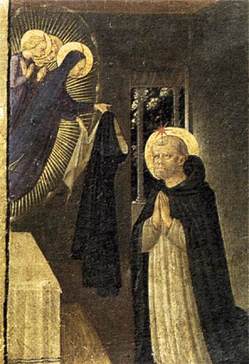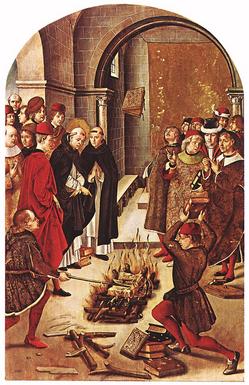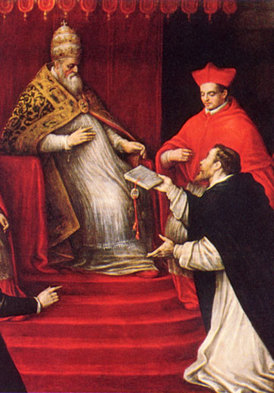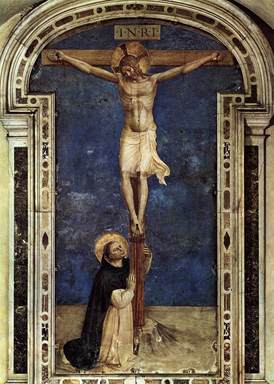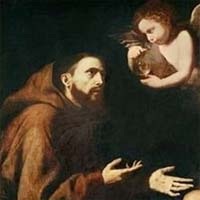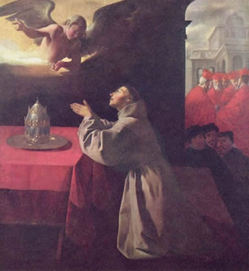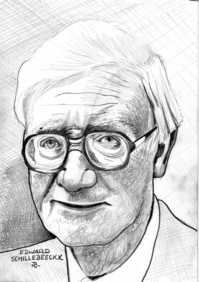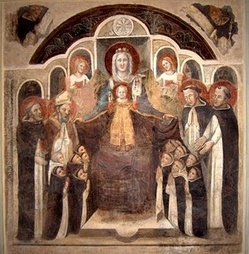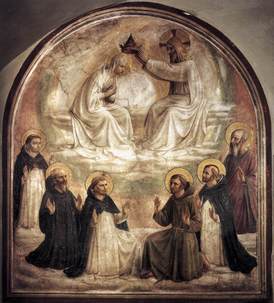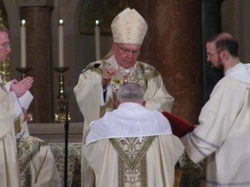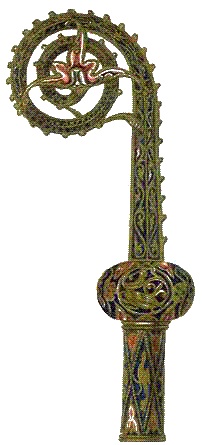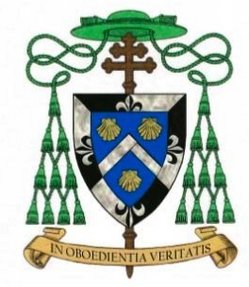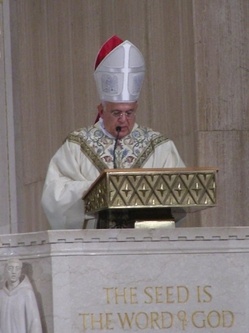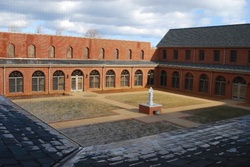This afternoon, I received a request for prayers, which I now recommend to you, for the Christians in Iraq. The following note was sent by Sister Donna Markham, the Prioress of the Adrian Dominicans:
Tag: Dominican
Saint Dominic helps us to discover the fruit of contemplation
I marveled at the Pope’s General Audience address on Saint Francis of Assisi last week. He’s given us more food to digest this week. Of course, I believe both of these addresses are the Pope’s corrective of the two great Orders of the Church. In many places both the Dominicans and the Franciscans have unhinged themselves from the living architecture of the Church and the Pope recognizes that we need these two charisms (and others, as well) to help the faith really thrive. I hope the Dominicans and Franciscans get the hint: if not, then we’re in trouble. Benedict XVI is telling us what’s in his heart and on his mind in these addresses, I hope the readers can read between the lines and do the hard work in reforming both groups of Friars.
Last week I
presented the luminous figure of Francis of Assisi; today I would like to speak
to you of another saint who, in the same period, made an essential contribution
to the renewal of the Church of his time. It is St. Dominic, the founder of the
Order of Preachers, known also as the Dominican Friars.
His successor in the
leadership of the order, Blessed Giordano di Saxony, gives a complete portrait
of St. Dominic in the text of a famous prayer: “Inflamed by zeal for God
and supernatural ardor, by your limitless charity and the fervor of a vehement
spirit, you consecrated yourself wholly with the vow of perpetual poverty to apostolic
observance and to evangelical preaching.” It is in fact this essential
feature of Dominic’s witness that is underlined: He always spoke with God and
about God. In the life of saints, love of the Lord and of neighbor, the seeking
of God’s glory and the salvation of souls always go together.
Dominic was born
in Spain, in Caleruega, around 1170. He belonged to a noble family of Old
Castille and, supported by an uncle priest, he was educated in a famous school
of Palencia. He was distinguished immediately for his interest in the study of
sacred Scripture and for his love of the poor, to the point of selling books,
which in his time constituted a good of great value, to help victims of famine
with what he collected.
Ordained a priest, he was elected canon of the chapter
of the cathedral in his native diocese, Osma. Although this appointment could
represent for him some motive of prestige in the Church and in society, he did
not interpret it as a personal privilege, or as the beginning of a brilliant ecclesiastical
career, but as a service to render with dedication and humility. Is not perhaps
the temptation to a career, to power, a temptation to which not even those who
have a role of leadership and governance in the Church are immune? I recalled
this a few months ago, during the consecration of some bishops: “We do not
seek power, prestige or esteem for ourselves. […] We know how in civil
society and often also in the Church things suffer because many people on whom
responsibility has been conferred work for themselves rather than for the
community” (Homily, Cappella Papale per l’Ordinazione episcopale di cinque
Ecc. mi Presuli, Sept. 12, 2009).
The bishop of Osma, who was named Diego, a
true and zealous pastor, very soon noticed the spiritual quality of Dominic,
and wished to make use of his collaboration. Together they went to Northern
Europe to carry out diplomatic missions entrusted to them by the king of
Castille.
While traveling, Dominic became aware of two great challenges for
the Church of his time: the existence of people who were not yet evangelized,
in the northern limits of the European continent, and the religious scourge
that weakened Christian life in southern France, where the action of some
heretical groups created disturbance and a falling away from the truth of the
faith. Missionary work on behalf of those who do not know the light of the
Gospel and the work of re-evangelization of the Christian community thus became
the apostolic goals that Dominic intended to pursue. It was the Pope, to whom
Bishop Diego and Dominic went to ask advice, who requested the latter to
dedicate himself to preaching to the Albigensians, a heretical group which held
a dualistic concept of reality, that is, of two equally powerful creative
principles, Good and Evil. This group, consequently, had contempt for matter as
coming from the principle of evil, even rejecting marriage, and reaching the
point of denying the incarnation of Christ, the sacraments in which the Lord
“touches” us through matter, and the resurrection of bodies. The
Albigensians esteemed a poor and austere life — in this sense they were even
exemplary — and they criticized the wealth of the clergy of that time.
Dominic
accepted this mission enthusiastically, which he carried out precisely with the
example of his poor and austere existence, with the preaching of the Gospel and
with public debates. He dedicated the rest of his life to this mission of
preaching the Good News. His sons would fulfill St. Dominic’s other dreams: the
mission ad gentes, that is, to those who did not yet know Jesus, and the
mission to those who lived in the city, especially in the universities, where
new intellectual tendencies were a challenge for the faith of the
well-educated.
This great saint reminds us that a missionary fire must always
burn in the heart of the Church, which drives incessantly to take the first
proclamation of the Gospel and, where necessary, to a new evangelization:
Christ is, in fact, the most precious good that men and women of all times and
all places have the right to know and to love! And it is consoling to see how
also in the Church of today there are so many — pastors and lay faithful,
members of old religious orders and of new ecclesial movements — that with joy
spend their life for this supreme ideal: to proclaim and witness the Gospel!
Other
men associated themselves to Dominic Guzmán, attracted by the same aspiration.
Thus, gradually, from the first foundation of Tolosa, was born the Order of
Preachers. Dominic, in fact, in full obedience to the directives of the Popes
of his time, Innocent III and Honorius III, adopted the ancient Rule of St.
Augustine, adapting it to the needs of apostolic life, which led him and his
companions to preach, moving from one post to another, but returning, later, to
their own monasteries, places of study, prayer and community life. In a
particular way, Dominic wished to highlight two values considered indispensable
for the success of the evangelizing mission: community life in poverty and
study.
First of all, Dominic and the Friars Preachers presented themselves as
mendicants, that is, without vast properties of land to administer. This
element rendered them more available for study and itinerant preaching and
constituted a concrete witness for the people. The internal government of the
Dominican monasteries and provinces was structured on the system of chapters,
which elected their own superiors, confirmed later by major superiors; hence,
an organization that stimulated fraternal life and the responsibility of all
the members of the community, exacting strong personal convictions. The choice
of this system stemmed precisely from the fact that the Dominicans, as preachers
of the truth of God, had to be consistent with what they proclaimed. Truth
studied and shared in charity with brothers is the most profound foundation of
joy. Blessed Giordano of Saxony said of St. Dominic: “He received every
man in the great bosom of charity and, because he loved everyone, everyone
loved him. He made a personal law for himself of being joyful with happy
persons and of weeping with those who wept” (Libellus de principiis
Ordinis Praedicatorum autore Iordano de Saxonia, ed. H.C. Scheeben, [Monumenta
Historica Sancti Patris Nostri Dominici, Romae, 1935]).
In the second place,
with a courageous gesture Dominic wished that his followers acquire a solid
theological formation, and he did not hesitate to send them to the universities
of the time, even though not a few ecclesiastics regarded with diffidence these
cultural institutions. The Constitutions of the Order of Preachers give great
importance to study as preparation for the apostolate. Dominic wanted his
friars to dedicate themselves to study, sparing no effort, with diligence and
compassion — to study founded on the soul of all theological learning, that
is, on sacred Scripture, and respectful of the questions posed by reason.
The
development of culture imposes on those who carry out the ministry of the Word,
at various levels, to be well prepared. Hence I exhort all, pastors and laity,
to cultivate this “cultural dimension” of faith, so that the beauty
of the Christian truth can be better understood and faith can be truly nourished,
reinforced and also defended. In this Year for Priests, I invite seminarians
and priests to appreciate the spiritual value of study. The quality of the
priestly ministry depends also on the generosity with which one applies oneself
to the study of revealed truths.
Dominic, who wished to found a religious Order
of Preachers-Theologians, reminds us that theology has a spiritual and pastoral
dimension, which enriches the spirit and life. Priests, consecrated persons and
also all the faithful can find a profound “interior joy” in
contemplating the beauty of the truth that comes from God, truth that is always
up-to-date and always living. Hence, the motto of the Friars Preachers —
contemplata aliis tradere — helps us to discover a pastoral yearning in the
contemplative study of such truth, by the need to communicate to others the
fruit of one’s contemplation.
When Dominic died in 1221 in Bologna, the city
that declared him its patron, his work had already had great success. The Order
of Preachers, with the support of the Holy See, had spread to many countries of
Europe to the benefit of the whole Church. Dominic was canonized in 1234, and
it is he himself, with his sanctity, who indicates to us two indispensable
means for apostolic action to be incisive. First of all, Marian devotion, which
he cultivated with tenderness and which he left as precious legacy to his
spiritual children, who in the history of the Church have had the great merit
of spreading the prayer of the holy rosary, so dear to the Christian people and
so rich in evangelical values, a true school of faith and piety. In the second
place, Dominic, who took care of some women’s convents in France and in Rome,
believed profoundly in the value of intercessory prayer for the success of
apostolic work. Only in Paradise will we understand how much the prayer of the
cloistered effectively supports apostolic action! To each one of them I direct
my grateful and affectionate thoughts.
Dear brothers and sisters, may Dominic
Guzmán’s life spur all of us to be fervent in prayer, courageous in living the
faith, profoundly in love with Jesus Christ. Through his intercession, we ask
God to enrich the Church always with genuine preachers of the Gospel.
The Mendicant witness of Christ and the Church is urgent & irresistible
The renewal of religious life is also one of Pope Benedict’s priorities. AND boy does it need it. The general state of religious life in this country at least, is circling the drain. Religious life’s sad state is not merely about gaining new recruits, or wearing habits or working with the marginalized, but being faithful to Christ and the Church today, not some fantasy of what one “guru” hopes the Church to be. There are notable exceptions to this evaluation, but even those orders getting vocations there are concerns with the institutional rot in the ranks, and therefore they are fragile. Benedict’s general audience address yesterday shows us the breadth and depth of the work needed to be done AND the desire to see the mendicant life thrive and contribute to the upbuilding of the Kingdom. Being faithful to the charism of the order and to the Magisterium of the Church are essential components to any hope of renewal. The Pope said:
At the beginning of the new year, we look at the history of Christianity, to see how a history develops and how it can be renewed. In it we can see that it is the saints, guided by the light of God, who are the genuine reformers of the life of the Church and of society. Teachers by their word and witnesses with their example, they know how to promote a stable and profound ecclesial renewal, because they themselves are profoundly renewed, they are in contact with the true novelty: the presence of God in the world.
Such a consoling reality — that in every generation saints are born and bear the creativity of renewal — constantly accompanies the history of the Church in the midst of the sorrows and the negative aspects of her journey. We also see come forth, century by century, the forces of reform and of renewal, because the novelty of God is inexorable and always gives new strength to go forward.
This was what happened in the 13th century, with the birth and the extraordinary development of the Mendicant Orders: a model of great renewal in a new historic period. They were called thus because of their characteristic of “begging,” namely, of going to the people humbly for economic support to live the vow of poverty and to carry out their evangelizing mission. Of the Mendicant Orders that arose in that period, the most notable and most important are the Friars Minor and the Preaching Friars, known as Franciscans and Dominicans. They have these names because of their founders, Francis of Assisi and Dominic de Guzmán, respectively. These two great saints had the capacity to wisely read “the signs of the times,” intuiting the challenges that the Church of their time had to face.
A first challenge was represented by the spread of several groups and movements of faithful that, although inspired in a legitimate desire for authentic Christian life, often placed themselves outside of ecclesial communion. They were in profound opposition to the rich and beautiful Church that developed precisely with the flourishing of monasticism. In recent catecheses I reflected on the monastic community of
This brought about the so-called pauper movements of the Medieval Age. They harshly contested the lifestyles of priests and monks of the time, accused of having betrayed the Gospel and of not practicing poverty as the first Christians, and these movements counterpoised to the ministry of the bishops their own “parallel hierarchy.” Moreover, to justify their choices, they spread doctrines that were incompatible with the Catholic faith. For example, the movement of the Cathars or Albigensians proposed again old heresies, such as depreciation and contempt of the material world — opposition to wealth quickly became opposition to material reality as such — the negation of free will, and then dualism, the existence of a second principle of evil equated with God. These movements had success, especially in
With an altogether original choice in the history of consecrated life, the members of these orders not only gave up possession of personal goods, as monks had since antiquity, but even wanted real estate and goods put in the name of the community. In this way they intended to give witness of an extremely sober life, to be in solidarity with the poor and trust only in
And fruits were not lacking: The poor groups that had separated from the Church returned to ecclesial communion or, gradually, were re-dimensioned until they disappeared. Also today, though living in a society in which “having” often prevails over “being,” there is great sensitivity to examples of poverty and solidarity, which believers give with courageous choices. Also today, similar initiatives are not lacking: movements, which really begin from the novelty of the Gospel and live it radically today, putting themselves in God’s hands, to serve their neighbor. The world, as Paul VI recalled in Evangelii Nuntiandi, willingly listens to teachers when they are also witnesses. This is a lesson that must never be forgotten in the endeavor of spreading the Gospel: to live first of all what is proclaimed, to be a mirror of divine charity.
Franciscans and Dominicans were witnesses, but also teachers. In fact, another widespread need in their time was that of religious instruction. Not a few lay faithful, who lived in greatly expanding cities, wished to practice a spiritually intense Christian life. Hence they sought to deepen their knowledge of the faith and to be guided in the arduous but exciting path of holiness. Happily, the Mendicant Orders were also able to meet this need: the proclamation of the Gospel in simplicity and in its depth and greatness was one objective, perhaps the main objective of this movement. In fact, with great zeal they dedicated themselves to preaching. The faithful were very numerous, often real and veritable crowds, which gathered to hear the preachers in the churches and in places outdoors — let us think of St. Anthony, for example. They dealt with themes close to the life of the people, especially the practice of the theological and moral virtues, with concrete examples, easily understood. Moreover, they taught ways to nourish the life of prayer and piety. For example, the Franciscans greatly spread devotion to the humanity of Christ, with the commitment of imitating the Lord. Hence it is not surprising that the faithful were numerous, women and men, who chose to be supported in their Christian journey by the Franciscan and Dominican friars, sought after and appreciated spiritual directors and confessors.
Thus were born associations of lay faithful that were inspired by the spirituality of Sts. Francis and Dominic, adapted to their state of life. It was the Third Order, whether Franciscan or Dominican. In other words, the proposal of a “lay sanctity” won many people. As the Second Vatican Council recalled, the call to holiness is not reserved to some, but is universal (cf. Lumen Gentium, 40). In every state of life, according to the needs of each, there is the possibility of living the Gospel. Also today every Christian must tend to the “lofty measure of Christian life,” no matter what state of life he belongs to!
The importance of the Mendicant Orders grew so much in the Middle Ages that lay institutions, such as labor organizations, ancient corporations and even civil authorities, often took recourse to the spiritual consultation of members of such orders for the writing of their regulations and, at times, for the solution of internal and external opposition. The Franciscans and Dominicans became the spiritual leaders of the Medieval city. With great intuition, they put into practice a pastoral strategy adapted to the transformation of society. Because many people were moving from the countryside to the cities, they placed their monasteries no longer in rural but in urban areas. Moreover, to carry out their activity for the benefit of souls, it was necessary to move in keeping with pastoral needs.
With another altogether innovative choice, the Mendicant Orders abandoned the principle of stability, a classic of ancient monasticism, to choose another way. Friars and Preachers traveled from one place to another, with missionary zeal. As a consequence, they gave themselves an organization that was different from that of the majority of monastic orders. In place of the traditional autonomy that every monastery enjoyed, they gave greater importance to the order as such and to the superior-general, as well as to the structure of the provinces. Thus the mendicants were in general available for the needs of the universal Church. This flexibility made it possible to send friars more adapted to specific missions and the Mendicant Orders reached
Another great challenge was represented by the cultural transformations taking place at that time. New questions made for lively discussions in the universities, which arose at the end of the 12th century. Friars and Preachers did not hesitate to assume this commitment as well and, as students and professors, they entered the most famous universities of the time, founded centers of study, produced texts of great value, gave life to true and proper schools of thought, were protagonists of scholastic theology in its greatest period, and significantly influenced the development of thought.
The greatest thinkers, Sts. Thomas Aquinas and Bonaventure, were mendicants, operating in fact with this dynamism of the new evangelization, which also renewed the courage of thought, of dialogue between reason and faith. Today also there is a “charity of and in truth,” an “intellectual charity” to exercise, to enlighten intelligences and combine faith with culture. The widespread commitment of the Franciscans and Dominicans in the Medieval universities is an invitation, dear faithful, to make oneself present in places of the elaboration of learning, to propose, with respect and conviction, the light of the Gospel on the fundamental questions that concern man, his dignity, and his eternal destiny. Thinking of the role of the Franciscans and Dominicans in the Middle Ages, of the spiritual renewal they aroused, of the breath of new life that they communicated in the world, a monk says: “At that time the world was growing old. Two orders arose in the Church, from which it renewed its youth, like that of an eagle” (Burchard d’Ursperg, Chronicon).
Dear brothers and sisters, let us indeed invoke at the beginning of this year the Holy Spirit, eternal youth of the Church: May he make each one of us feel the urgency of giving a consistent and courageous witness of the Gospel, so that saints will never be lacking, who make the Church shine as a Bride always pure and beautiful, without stain and without wrinkle, able to attract the world irresistibly to Christ, to his salvation.
Edward Schillebeeckx, OP, RIP
Feast of the Patronage of Our Lady of the Order of Friars Preachers
O God, who for the salvation of souls didst place the Order
of Preachers under the special protection of the most Blessed Virgin Mary, and
wast please to pour out upon it her constant benefits: grant unto thy
suppliants that we may be led unto the joy of heaven through the aid of that
same protectress whose memory we revere today. Through Christ our Lord. Amen.
Pray for the Friars Preachers on the anniversary of papal approval in 1216.
Dominican & Franciscan vocation videos
I stumbled upon these vocation videos of the Polish Dominicans and Franciscans. If you don’t understand Polish, don’t fret, neither do I. And since there’s no talking, just music, just sit back and enjoy the brief videos. THE fun thing is just watching the Dominican Franciscan friars. You get a great sense of the spirit of the friars of both groups just by watching the life.
J. Augustine DiNoia ordained bishop
Since you have purified
yourselves by obedience to the truth for sincere mutual love, love one another
intensely from a pure heart. (1 Peter 1:22)
Today, a most beautiful DC day, with great joy and fanfare
the Church ordained Father Joseph
Augustine DiNoia, O.P., 66, a bishop. The setting was the beautiful Basilica of the National Shrine of the Immaculate Conception. The drama of the Liturgy couldn’t come together in your theological imagination better than when you read the words in dome over the sanctuary which reads, in part: “Jesus has pored forth His Spirit you see and hear.” Right, the Lord poured forth his Spirit upon Father Augustine ordaining him a bishop.
He was appointed by the Holy
Father the titular archbishop of Oregon City. Even more to the point, he’s the
archbishop secretary of the Congregation
for Divine Worship and the Discipline of the Sacraments; this office
is part of the Roman Curia so Archbishop DiNoia works for the Pope.
William
Cardinal Levada was the consecrating prelate with the assistance of Archbishop Thomas Cajetan Kelly, OP and Archbishop Donald W. Wuerl. Antonio Cardinal Cañizares Llovera was supposed to be here but he forgot his passport at home and didn’t have time to run back to the Vatican to get it and make the flight. Easily 250 priests and a handful of bishops including three other cardinals.
The image to the right is of Fra Angelico’s Coronation of the Virgin (at the Convent of San Marco) was used for the invitation, worship aid and remembrance card. Talk about theology and Liturgy!
When the Papal Bull was read by the Dominican Provincial Father Dominic Izzo you heard the Pope say of DiNoia: you are a beloved son, suitable for the office of bishop because you manifest gifts of mind and heart, piety, diligence, experience and prudence; you are now asked by the Church to use these gifts for the up-building of the Church through the work of Liturgy and the sacraments.
In the context of the Eucharist, family, friends, colleagues (past and present) and others who thought it best to attend, gathered to pray for the Spirit to come down upon Father Augustine so that he receive the gift of the fullness of Order, i.e., a bishop. We were reminded by Cardinal Levada that following ancient belief and practice the mission given to the apostles through Holy Spirit and imposition of hands the Tradition is preserved until today. The action of the Holy Spirit and the Church Father Augustine was conformed to the three-fold work of Christ as teacher, shepherd and priest not for himself but to join with Saint Peter and the apostles, Pope Benedict and the entire college of bishops in communion with the pope. Therefore, the doctrine is that a real “communio” exists with Augustine and the Pope and with every bishop in the world. So our Catholic belief here is that Father Augustine lives as Christ’s vicar because of his episcopal character having particular care and solicitude for all the Church.
The notion of episcopal solicitude means that a bishop builds up the body of Christ not only at the local level but worldwide. How is this done? Going back to the point of calling on the Spirit to come down upon the person to be ordained and the anointing with oil. Delving deeper into this dramatic Liturgy we notice that the Church invokes the Trinity, the saints and angles to come upon Father Augustine who abandons himself to Christ in humility in an act of humility seen in his prostration before the altar. Moments later the cardinal imposed hands (with the other bishops) and poured oil on the head and gave the visible ornaments of the bishop’s office (ring, mitre and crosier). Capping the ritual off was the seating of the bishop and the sign of peace. BUT, I think we need to reflect on the cardinal’s words when said we are all to look to the “destiny of divine embrace” as all of heaven gazes down upon Augustine. Here we realize the promises of Christ. And to that, the saints and angels lift Augustine’s gaze heavenward while the Trinity gives the grace to preach the gospel with constancy and faithfully.
Cardinal Levada reminded us of the tall order DiNoia was called to: to live and teach Gospel in truth. As a point in history he renews his commitment to the truth of Gospel. Remember: truth is not a thing but a Person. Truth, you will recall, makes us free for the service of Christ oriented toward the liberation of the world.
A nice point of continuity with Dominican history is that Archbishop DiNoia used the crosier of Father Benedict Edward Fenwick, OP, founder of the Dominican Province of Saint Joseph and bishop of Cincinnati. Other points of continuity were the presence of the archbishop’s chaplains Dominican Fathers Gabriel B. O’Donnell (JAD’s ordination classmate & my spiritual father) and Romanus Cessario. One can’t overlook all of the Dominican family and friends who travelled long distances to support him.
Archbishop DiNoia’s episcopal motto is In
Oboedientia Veritatis. The explanation given comes from a papal homily:
“A
beautiful phrase from the First Letter of St. Peter springs to my mind. It is
from verse 22 of the first chapter. The Latin goes like this: ‘Castificantes
animas nostras in oboedentia veritatis.’ Obedience to truth must ‘purify’ our souls
and thus guide us to upright speech and upright action. In other words,
speaking in hope of being applauded, governed by what people want to hear out
of obedience to the dictatorship of current opinion, is considered to be a sort
of prostitution: of words and of the soul. The ‘purity’ to which the Apostle
Peter is referring means not submitting to these standards, not seeking
applause, but, rather, seeking obedience to the truth…This is the fundamental
virtue for the theologian, this discipline of obedience to the truth; it makes
us, although it may be hard, collaborators of the truth, mouthpieces of the
truth. For it is not we who speak in today’s river of words, but it is the
truth which speaks in us, who are really purified and made chaste by obedience
to the truth. So it is that we can truly be harbingers of the truth.” (Pope
Benedict XVI, Redemptoris Mater Chapel, Apostolic Palace)
Finally, the whole ecclesial event was a wonderful grace for Archbishop DiNoia and in that my own friendships were renewed by seeing so many very friends, plus making new ones.
St Dominic’s Monastery: 1st anniv in Linden, VA
Today, June 24, is the first anniversary of the dedication of Saint Dominic’s
Monastery new monastery in Linden, Virginia.
What an amazing year!
This summer four young women will enter the Monastery as postulants. As
envisioned, the Monastery is acting as a magnet attracting young women to
devote their lives to God. The life follows the traditional form of Second Order Dominican nuns with the night Office, the grill, silence, sacrifice and prayer. The nuns rarely leave the cloister and are completely focussed on Christ.
I would like to encourage everyone to send Sister Mary Paul (the
prioress) and the nuns at Saint Dominic’s Monastery an anniversary card and, if
possible, to include an anniversary gift – a check to support the formation of
their new members.
Cards can be mailed to:
Sister Mary Paul, O.P.
Saint Dominic’s Monastery
2636 Monastery Road
Linden, VA 22642
My friends Fathers Gabriel and Jordan as well as the laywoman Julie tell me the life of the monastery is going extremely well and the need for assistance is also great. So, I think the life of these Dominican nuns is VERY worth a sacrificial gift. Don’t you?
J. Augustine DiNoia, Dominican & Archbishop
 Today, the Holy Father nominated Dominican Father Joseph Augustine Di Noia, 66, as the archbishop secretary of the Congregation for Divine Worship and the Disciple of the Sacraments. He is given the archepiscopal dignity and is assigned the Titular See of Oregon City.
Today, the Holy Father nominated Dominican Father Joseph Augustine Di Noia, 66, as the archbishop secretary of the Congregation for Divine Worship and the Disciple of the Sacraments. He is given the archepiscopal dignity and is assigned the Titular See of Oregon City.
Recently in the School of Community
People who follow the life of Communion & Liberation meet weekly for what is called the School of Community, a catechetical session which works on a particular idea of Msgr. Giussani’s. The catechesis is supposed to make the connection with one’s experience and a lofty theological opinion, as much as theological opinions are helpful from time-to-time. This year we are working on volume 2 of Is It Possible to Live This Way: Hope. (This follows on a book we worked on last year by a similar title though the subject then was faith and it is expected that we’ll work on volume 3 next year dealing with charity.)
Our group is faithful to coming together for the shared experience of learning the faith and sharing friendship. A great grace indeed.
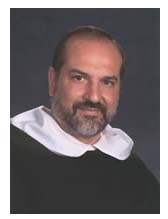 Last evening we had the distinct privilege of welcoming the Master of the Order of Preachers, Father Carlos Azpiroz-Costa for 15 minutes to our meeting. Father Carlos is the successor of Saint Dominic de Guzman. He took a personal interest in all of us. He’s here in the US doing the work of the Order. Without prompting he mentioned that he’s speaking with the Dominicans (and others) about the intimate connection between faith and reason as particularly being Catholic and very needed today. Hence, he’s fleshing out the work of Pope John Paul II and now Pope Benedict. Father Carlos was incredibly encouraging of our friendship and work with the local priory of Dominicans in New Haven. May God grant him many blessings!
Last evening we had the distinct privilege of welcoming the Master of the Order of Preachers, Father Carlos Azpiroz-Costa for 15 minutes to our meeting. Father Carlos is the successor of Saint Dominic de Guzman. He took a personal interest in all of us. He’s here in the US doing the work of the Order. Without prompting he mentioned that he’s speaking with the Dominicans (and others) about the intimate connection between faith and reason as particularly being Catholic and very needed today. Hence, he’s fleshing out the work of Pope John Paul II and now Pope Benedict. Father Carlos was incredibly encouraging of our friendship and work with the local priory of Dominicans in New Haven. May God grant him many blessings!
